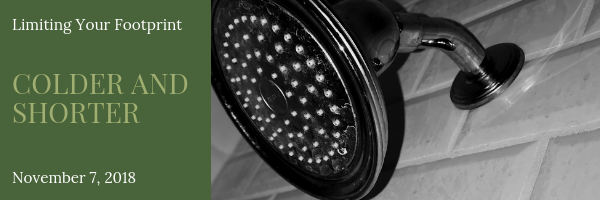
As we are approaching the colder months, maybe you have the urge to linger in a steaming hot shower for a little bit longer than normal. But hopefully with a little more knowledge on the environmental impacts, you will be more cautious.
The statistics for water and energy consumption in the shower vary widely depending on the shower head you have. There are some made to save a little water but there are some that are made for high pressure and release more water than average. If you have the ability to replace your shower head, consider looking into the water usage and finding an environmentally friendly one. Newer showerheads are regulated to have a maximum flow rate of 2.5 gallons per minute but if you have an older showerhead, your flow rate could be closer to 5 gallons per minute. (slate.com) Showerheads are relatively inexpensive so you should consider replacing yours.
But, no matter what shower head you have, you can limit your footprint in many ways:
- The first would be the most obvious, cut back on overall shower time. A few minutes off each shower at the regulated 2.5 gallons of water per minute can add up over a lifetime.
- Don’t let any water go to waste. Avoid turning the shower on until you are absolutely ready to get in it. Also, if your shower takes a minute or two to reach your desired temperature, challenge yourself to step in and start when it is still cold.
- Make your whole shower a little colder. This can be a little challenging on a chilly winter day but in the summer time or after a sweaty workout, maybe the cold water will feel just as good, if not better than the warm.
- Avoid shaving or brushing your teeth in the shower. This may seem like an obvious change but as shaving in the shower becomes normal, it is a good time to reflect on your water usage. I recently shared another post titled Shave by Save and in there you will find more about shaving.
- The final way to save the most water is to take a “military shower” as some call it. This is when the water is only turned on briefly at the beginning and end of your shower to rinse and it is kept off while you apply soap and/or shampoo.
Also, aside from the environmental impacts, sometimes sacrificing what you were given is a way of humbling yourself to connect with those less fortunate. My people around the world, starting in our own country, do not have access to hot water or even running water. If we can remind ourselves that many people can thrive without it, the sacrifice won’t seem as large.
Now, some of these changes might seem a little extreme or out of your reach, but remember that no change is too small and every change makes a difference. You can start by changing just one shower a week and see how you can adapt. Hot water makes our lives comfortable but it is certainly not a necessity. Take a step back to limit your footprint.
Works Cited
Rastogi, Nina Shen. “Exactly How Bad Should I Feel about Taking Hot Showers?” Slate Magazine, Slate, 27 Oct. 2009, slate.com/technology/2009/10/exactly-how-bad-should-i-feel-about-taking-hot-showers.html.